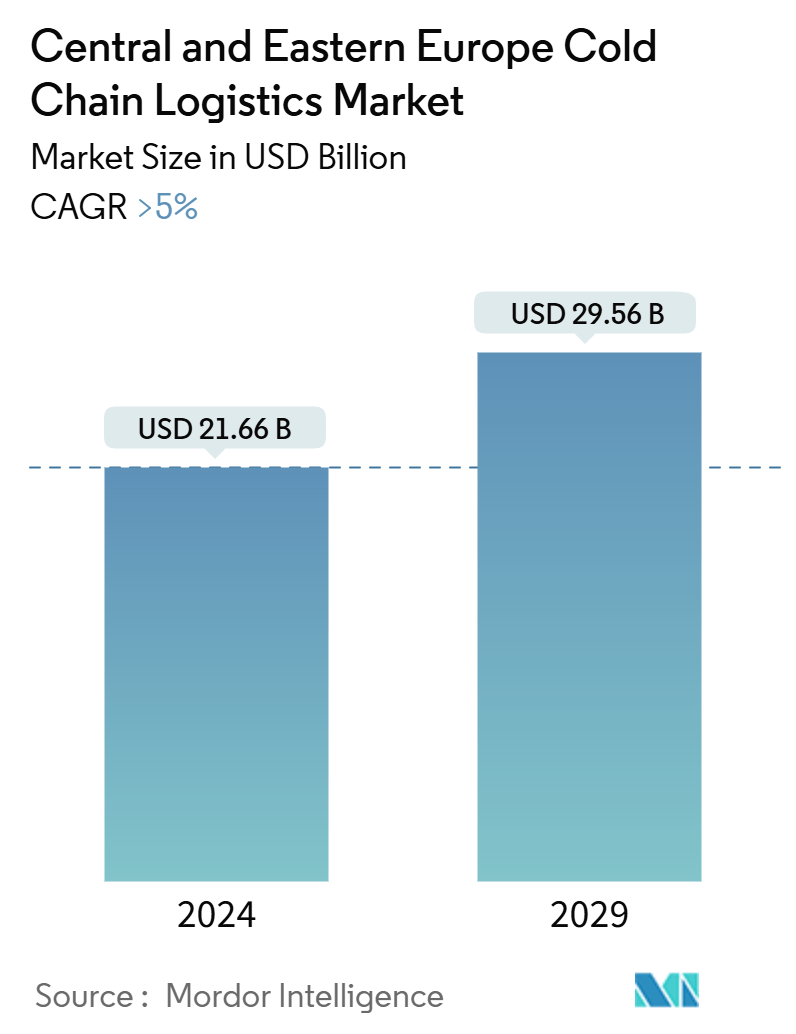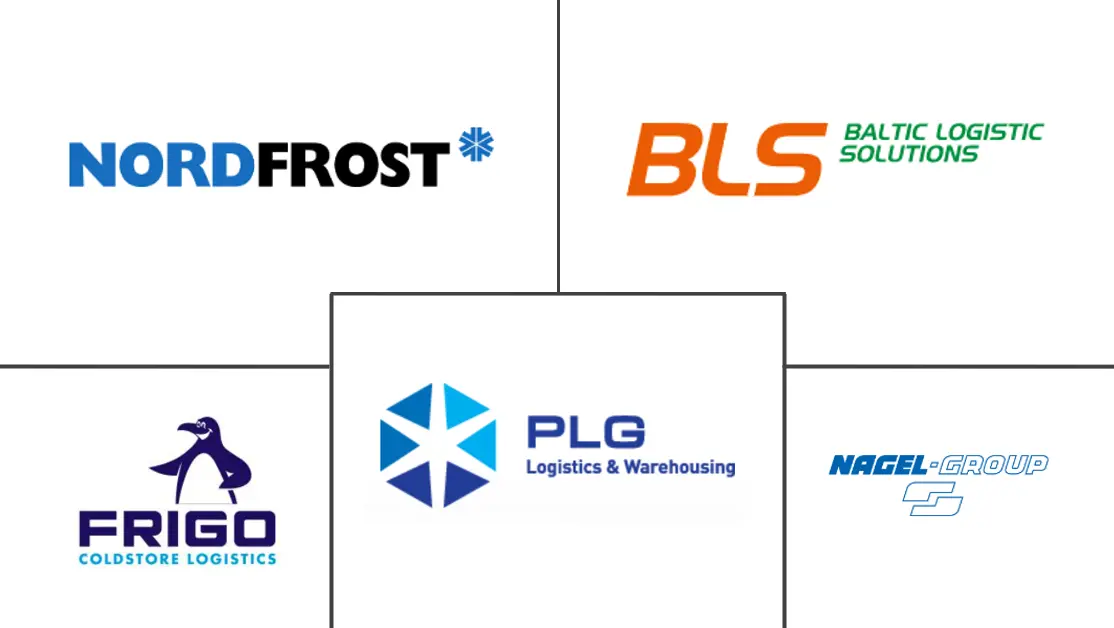| Study Period | 2020 - 2029 |
| Base Year For Estimation | 2023 |
| Forecast Data Period | 2024 - 2029 |
| Market Size (2024) | USD 21.66 Billion |
| Market Size (2029) | USD 29.56 Billion |
| CAGR (2024 - 2029) | 5.00 % |
| Market Concentration | Low |
Major Players*Disclaimer: Major Players sorted in no particular order |
Central and Eastern Europe Cold Chain Logistics Market Analysis
The Central And Eastern Europe Cold Chain Logistics Market size is estimated at USD 21.66 billion in 2024, and is expected to reach USD 29.56 billion by 2029, at a CAGR of greater than 5% during the forecast period (2024-2029).
Initially, when lockdown measures driven by the COVID-19 pandemic started in March 2020, consumers began panic buying and stockpiling items, with a focus on shelf-stable products. This reduced reefer trucking demands in the EU during Q1 and Q2 2020. The tourist accommodation industry in the EU also saw a sharp decline due to travel restrictions in March and April 2020, which also impacted the expected seasonal demand for reefer goods. However, the situation eased and demand picked up slowly over the next few weeks due to increased sales of alcohol and other beverages.
Labor shortages, increasing energy costs, market consolidation, and a reconfiguration in global food supply chains are some of the challenges in the European cold chain warehousing sector. Labor and energy are the two dominant cost components at European facilities. In 2020, labor accounted for 44% of total costs, with energy accounting for 15%. Covid-19 has pushed food companies to rethink their supply chain designs. The war in Ukraine and subsequent sanctions have accelerated this process.
Because the reconfigured supply chains will change where materials and products are stored, the cold storage sector is directly impacted. Many food companies have opted for just-in-case because the sector has seen a rise in occupancy rates - up to 90%.
Monitoring, storage, and transportation are important factors in the cold chain to avoid degradation in the quality of shipments. Cold chain logistics are anticipated to witness significant growth over the years, owing to the rise in the need for cold chain logistics in the pharmaceutical industry. At present, Germany dominates the market. The Europe cold chain logistics market is driven by growing penetration of e-commerce in the industry, changing lifestyles, increasing tech-driven logistics services, rising number of the refrigerated warehouse, and the growing pharmaceutical sector.
Central and Eastern Europe Cold Chain Logistics Industry Segmentation
Cold chain logistics consists of the storage and transportation of temperature-sensitive products along the supply chain by using thermal refrigerated packaging methods and logistical planning so that the integrity of these shipments is protected. Cold chain products are transported through various means such as refrigerated railcars & trucks, reefers & air cargos, refrigerated cargo ships, and others. Major elements of cold chain logistics consist of cooling systems, cold storage, cold transport, and cold processing & distribution.
The Central and Eastern Europe Cold Chain Logistics Market is segmented by service, temperature, application, and geography. By service, the market is segmented into storage, transportation, and value-added services. By temperature, the market is segmented into chilled and frozen. By application, the market is segmented into fruits and vegetables, dairy products, fish, meat and poultry, processed food, pharmaceutical, bakery and confectionery, and other applications. By geography, the market is segmented into Poland, Slovakia, the Czech Republic, Hungary, Romania, and the Rest of Central and Eastern Europe.
| Storage |
| Transportation |
| Value-added Services (Blast Freezing, Labeling, Inventory Management, etc.) |
| Chilled |
| Frozen |
| Fruits and Vegetables |
| Dairy Products (Milk, Butter, Cheese, Ice Cream, etc.) |
| Fish, Meat and Poultry |
| Processed Food |
| Pharmaceutical (Including Biopharma) |
| Bakery and Confectionery |
| Other Applications |
| Poland |
| Slovakia |
| Czech Republic |
| Hungary |
| Romania |
| Rest of Central and Eastern Europe |
Central And Eastern Europe Cold Chain Logistics Market Size Summary
The Central and Eastern Europe cold chain logistics market is poised for significant growth, driven by the increasing demand for temperature-sensitive logistics solutions across various sectors. The market is characterized by its fragmented nature, with numerous international and local players such as Kuehne + Nagel, Lineage Logistics, and others actively participating. The sector is experiencing advancements with the introduction of innovative technologies like solar-powered refrigerated units and multi-temperature trucks, which are enhancing the efficiency of cold chain operations. The market's expansion is further supported by the growing penetration of e-commerce, changing consumer lifestyles, and the rising pharmaceutical industry, particularly in countries like Germany, which is a leading pharmaceutical manufacturing hub in the European Union.
The COVID-19 pandemic initially disrupted the cold chain logistics demand due to lockdowns and reduced travel, but the market quickly rebounded as consumer demand shifted towards essential goods and beverages. Challenges such as labor shortages and increasing energy costs continue to impact the sector, prompting companies to rethink their supply chain strategies. The pharmaceutical industry, historically a minor consumer of cold chain logistics, has seen a surge in demand due to the rise of biologics, necessitating temperature and time-controlled distribution. As e-commerce continues to grow, particularly in Western Europe, optimizing cold chain logistics becomes crucial for businesses aiming for long-term success in the region.
Central And Eastern Europe Cold Chain Logistics Market Size - Table of Contents
1. MARKET DYNAMICS
- 1.1 Market Overview
-
1.2 Market Dynamics
- 1.2.1 Drivers
- 1.2.2 Restraints
- 1.3 Value Chain / Supply Chain Analysis
- 1.4 Industry Policies and Regulations
- 1.5 Technological Developments in the Sector
- 1.6 Industry Attractiveness - Porter's Five Forces Analysis
- 1.7 Impact of COVID-19 on the Market
2. MARKET SEGMENTATION
-
2.1 By Service
- 2.1.1 Storage
- 2.1.2 Transportation
- 2.1.3 Value-added Services (Blast Freezing, Labeling, Inventory Management, etc.)
-
2.2 By Temperature
- 2.2.1 Chilled
- 2.2.2 Frozen
-
2.3 By Application
- 2.3.1 Fruits and Vegetables
- 2.3.2 Dairy Products (Milk, Butter, Cheese, Ice Cream, etc.)
- 2.3.3 Fish, Meat and Poultry
- 2.3.4 Processed Food
- 2.3.5 Pharmaceutical (Including Biopharma)
- 2.3.6 Bakery and Confectionery
- 2.3.7 Other Applications
-
2.4 By Geography
- 2.4.1 Poland
- 2.4.2 Slovakia
- 2.4.3 Czech Republic
- 2.4.4 Hungary
- 2.4.5 Romania
- 2.4.6 Rest of Central and Eastern Europe
Central And Eastern Europe Cold Chain Logistics Market Research Faqs
How big is the Central and Eastern Europe Cold Chain Logistics Market?
The Central and Eastern Europe Cold Chain Logistics Market size is expected to reach USD 22.74 billion in 2025 and grow at a CAGR of greater than 5% to reach USD 29.03 billion by 2030.
What is the current Central and Eastern Europe Cold Chain Logistics Market size?
In 2025, the Central and Eastern Europe Cold Chain Logistics Market size is expected to reach USD 22.74 billion.




